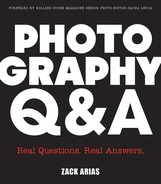Foreword
Q: HI SACHA. THANKS FOR TAKING MY QUESTION, AND THANKS FOR WRITING THIS FOREWORD. AS A SENIOR PHOTO EDITOR AT ROLLING STONE, YOU MUST SEE A LOT OF WORK FROM PHOTOGRAPHERS. I’M A FAIRLY NEW PHOTOGRAPHER IN THE EDITORIAL WORLD, AND I’M WONDERING WHAT CATCHES YOUR ATTENTION ENOUGH TO PICK UP THE PHONE AND CALL A PHOTOGRAPHER YOU HAVEN’T WORKED WITH BEFORE. IS IT THE QUALITY OF THE WORK? IS IT A GUT INSTINCT? YOUR NECK CAN BE ON THE LINE WHEN WORKING WITH SOMEONE NEW. HOW DO YOU KNOW WHO IS OR WHO IS NOT GOING TO WORK WELL WITH YOU?
A: Zack,
Knowing what this book is—and its aim to demystify for beginning photographers certain aspects of what it means to be a working photographer—I really should have expected this very question. I hope I can do it justice.
Most publications have a list of preferred photographers who do regular work for them, and breaking into that lineup is not an easy thing to do. That being said, picture editors like myself are always looking at photography and for new (or new to them) talent. I try to stay engaged in this process as much as I can by checking out emailed and printed promos, photo books, magazines, blogs, and zines, as well as attending portfolio reviews, gallery shows, etc.
So, by the time I’ve picked up the phone to make that call to someone new to shoot for Rolling Stone (or even just for a meeting), more often than not I have probably been looking at their work for a while—basically stalking them. I might have been checking out their Tumblr, Instagram, blog, and/or web site from time to time; looking at their latest shoots; or discussing them with coworkers and photo editors at other magazines. It isn’t always about seeing one amazing shot. It can help to see someone’s progression over time. That way, I get a better sense of their personal style, how they handled a particular situation, and what kind of subjects they seem to best connect with. Watching their body of work evolve also helps to get to know them better, to get a sense of the kind of person they are.
More to your question...so what is it that makes me pay attention in the first place? You asked, “Is it the quality of the work? Is it a gut instinct?” Both are true.
I’m surrounded by photography—my parents are both photographers, my twin sister is a visual artist, my wife is also a photo editor, I shoot a bit, and every day I work with photographers young and old—so I’m frequently fascinated with the processes they employ, the tools they use (cameras, lenses, film stock), how a shoot went, whatever. I totally nerd out on that. However, when I see an image that hits me hard and really connects with me, it’s as if all those details fall away and they’re the last thing I consider...if I consider them at all. The greatness of an image is in the intangibles.
I have my own tastes, which may differ from those of my coworkers, and since one of our tasks is to consider how someone’s work could be applied within the pages of Rolling Stone, some discussion may occur around the office about someone being the right fit for the magazine and/or for a particular assignment.
If you are thinking about submitting work to us, I think it’s a great idea to be as familiar as possible with Rolling Stone (this would apply to any publication you’d like to work for). Know the different sections and the style of work used in each, the photographers that are employed and how. If you consider your work to be a good fit, then hit us up.
—Sacha Lecca
Senior Photo Editor, Rolling Stone magazine
